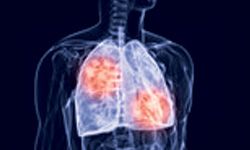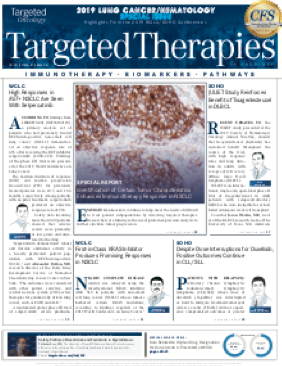Patients With Rare Gene Fusion NRG1 Respond to Afatinib in NSCLC
Four patients with lung adenocarcinoma with NRG1 fusions demonstrated some degree of response or tumor stabilization when given afatinib, according to a poster presentation at the 2019 World Conference on Lung Cancer meeting. The findings suggest that the irreversible pan-ERBB inhibitor is a potential treatment in this rare mutation of lung adenocarcinoma.

Four patients with lung adenocarcinoma withNRG1fusions demonstrated some degree of response or tumor stabilization when given afatinib (Gilotrif), according to a poster presentation at the 2019 World Conference on Lung Cancer meeting.1The findings suggest that the irreversible pan-ERBB inhibitor is a potential treatment in this rare mutation of lung adenocarcinoma.
“These findings add to a growing body of evidence suggesting afatinib activity inNRG1fusionpositive non–small cell lung cancer (NSCLC),” Michael Duruisseaux, MD, of the Lyon Cancer Institute in France, and colleagues reported in a poster presentation during the meeting. “Mutational testing of patients with solid tumors may help to identify potentially targetable genomic aberrations, such as NRG1 fusions. This may be particularly important in lung invasive mucinous adenocarcinoma, whereNRG1fusion prevalence is relatively high.”
NRG1 is a growth factor containing an epi- dermal growth factorlike domain that binds to ERBB3 or ERBB4 to activate ERBB signaling pathways. Clinically actionableNRG1gene fusions that may function as oncogenic drivers have been identified in multiple tumor types, including NSCLC, the investigators noted.
NRG1fusions have an estimated prevalence of about 0.2% in various solid tumors, but the prevalence in lung invasive mucinous adeno- carcinoma could be as high as 31%.
Afatinib may represent a viable therapeutic option forNRG1-associated lung adenocarcinoma, Duruisseaux and colleagues continued. They described 4 new cases ofNRG1fusionpositive lung adenocarcinoma treated with afatinib.
A 70-year-old nonsmoking Caucasian woman had a diagnosis of pan-wild type, nonmucinous lung adenocarcinoma in 2004 and received 14 lines of therapy prior to afatinib, including chemotherapy and targeted agents. The patient initiated afatinib in February 2015, had a rapid initial response, and remained on treatment until March 2017, when she developed progressive disease.
AnNRG1fusion was identified in October 2017 by NanoString analysis, and the patient reinitiated afatinib at 30 mg daily, which led to regression of lung condensations. The patient discontinued afatinib after 3 months because of cough and fever, but reinitiated afatinib in April 2018. Treatment continued until August 2018, when disease progression occurred.
The second case involved a 66-year-old non- smoking Asian woman with low body weight. In June 2015, the patient had diagnosis of metastatic nonmucinous lung adenocarcinoma, with multiple lung and lymph node metastases. The patient had received 4 prior lines of therapy, including nivolumab (Opdivo) and docetaxel/ ramucirumab (Cyramza).
In December 2017, the patient received afatinib treatment at 40 mg daily after detection of a CD74-NRG1fusion. After several dose adjustments because of diarrhea and malaise, the patient attained a partial response (PR), which was ongoing after 19 months of follow-up.
The third patient was a 68-year-old Caucasian man with a ≥20 pack-year history of smoking. He had cinous invasive lung adenocarcinoma in January 2016. He received 2 prior lines of therapy: cisplatin/pemetrexed chemotherapy, which led to progressive disease as best response, and nivolumab, which resulted in a PR. The patient remained on the PD-1 inhibitor from September 2016 to March 2017, when the treatment was discontinued because of progressive disease associated with immune hepatitis.
Following detection of an SDC4-NRG1fusion, the patient was given afatinib at 30 mg daily in August 2018 and attained stable disease for 4 months. At disease progression, that patient chose not to have further treatment.
A diagnosis of invasive mucinousade- nocarcinoma of the lung in August 2016 formed the basis for the fourth case, a 43-year-old non-smoking Caucasian woman. Her treatment history consisted of pemetrexed/cisplatin chemotherapy plus bevacizumab (Avastin), followed by bevacizumab/pemetrexed maintenance until July 2017. She then received nivolumab until September 2017, when RNA sequencing identified a CD74-NRG1fusion.
The patient initiated treatment with afatinib, which led to a major PR, and treatment is ongoing.
“A prospective study of a larger cohort of patients withNRG1fusionpositive NSCLC treated with afatinib is warranted to better evaluate its potential activity,” the investigators concluded in their poster.
Reference:
Duruisseaux M, Laskin JJ, Tolba K, et al. Targeting NRG1-fusions in lung adenocarcinoma: afatinib as a novel potential treatment strategy. Present- ed at: 2019 International Association for the Study of Lung Cancer World Conference on Lung Cancer; September 7-10, 2019; Barcelona, Spain; Abstract P1.14-25.

Survivorship Care Promotes Evidence-Based Approaches for Quality of Life and Beyond
March 21st 2025Frank J. Penedo, PhD, explains the challenges of survivorship care for patients with cancer and how he implements programs to support patients’ emotional, physical, and practical needs.
Read More